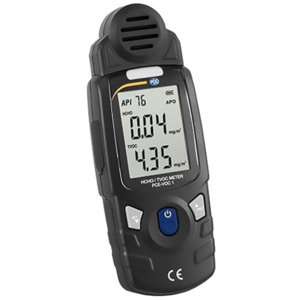
- Description
- Specifications
- Documents
- Measures total volatile organic compound (TVOC) and formaldehyde (HCHO) levels
- Displays units in parts per million (ppm) or milligrams per cubic meter (mg/m³)
- Audible and visual alarms
- Large, easy-to-read LCD screen
- User-friendly three-button operation
- Long-lasting rechargeable lithium-polymer (LiPo) battery
- Compact and lightweight yet heavy-duty design
- Ideal for measuring TVOC and HCHO in homes, schools, factories, offices, laboratories, hotels and other indoor environments
- Alarm sounds and LCD screen turns red when critical VOC or HCHO level is reached
- Response time of less than 2 seconds
The PCE-VOC 1 is a portable handheld volatile organic compound (VOC) and Formaldehyde (HCHO) gas detector for indoor air quality monitoring. It recognizes gases within seconds and displays their concentrations on the easy-to-read LCD screen. The values are displayed in parts per million (ppm) or milligrams per cubic meter (mg/m3). If a critical VOC or HCHO level is reached the device will emit an audible alarm and the LCD screen will turn red.
This easy-to-use VOC/ HCHO meter is ideal for measuring total volatile organic compound (TVOC) and formaldehyde (HCHO) levels in homes, offices, factories, laboratories, hotels, schools and other indoor environments. The meter's long-lasting rechargeable lithium-polymer (LiPo) battery and included 9V power adapter/charger ensure uninterrupted IAQ monitoring.
Volatile Organic Compounds (VOC)
VOCs are airborne gaseous or vaporous substances of organic origin. Examples of VOCs include hydrocarbons, alcohols, aldehydes and organic chemicals. Many detergents, solvents, paints, varnishes, adhesives and other synthetically manufactured substances can produce VOCs. In addition, numerous naturally occurring organic compounds formed by biological processes such as plant metabolism, decay and degradation can create VOCs. VOCs can become airborne through evaporation or emission. Evaporation sources can include household cleaning products, construction and building materials, and indoor furnishings, flooring and decor. Emission sources can include traffic exhaust, tobacco or cigarette smoke and industrial pollution. Even food preparation and human metabolism can be sources for airborne VOCs.
How can indoor VOC concentrations be reduced?
Consumers should choose low-emission products and materials. Environmentally friendly labeling such as the Blue Angel is a helpful purchasing aid. Construction materials successfully tested according to the AgBB scheme with a recognized Ecolabel provide assurance that the potential for VOC emissions is minimized. Regular testing, adjusting and balancing (TAB) of HVAC systems should be performed to alleviate VOC concentration through proper ventilation.
What's in the Box
- PCE-VOC 1 gas detector
- 9V power adapter/charger
- 7.4V rechargeable LiPo battery
- User manual
